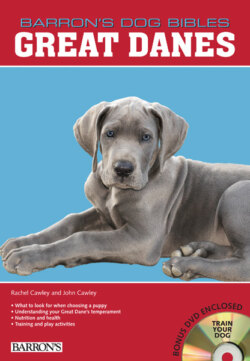Читать книгу Great Danes - Rachel Cawley - Страница 24
На сайте Литреса книга снята с продажи.
PERSONALITY POINTERS
ОглавлениеGreat Dane Body Language
| Mood | Friendly | Curious or Excited | Playful | Apprehensive or Anxious | Fearful | Subordinate |
|---|---|---|---|---|---|---|
| How he holdsh is head | Normal posture and head position | Extended neck and possible tilted head | “Play bow,” chest and head down, rump in air | Neck stiff, head may be pulled back slightly or lowered to shoulder | Neck stiff, head may be pulled back slightly or lowered to shoulder | Head slightly lowered to shoulder height |
| His eyes | Wide open | Wide open or possibly squinting | Wide open | Wide open, eyes may wander | Eyes wide, whites of eyes may show, may try to look away | Eyes partially closed |
| His ears | Alert, forward, or off to the side | Perked forward | Alert, forward, or off to the side | Pulled back | Ears pulled back or flattened against skull | Ears flattened against skull |
| His mouth | Mouth open, tongue often in a “smile” | Mouth partially open, one side of lip may be raised | Mouth open, tongue often in a “smile” | Mouth slightly open with random tongue licking | Mouth slightly open with random tongue licking | Lips of mouth pulled back in “grin,” may lick or nuzzle |
| His body | Relaxed posture or wiggling with excitement, hopping | Relaxed posture | Chest lowered to ground, rump elevated | Arched back, may be bristled | Arched back, may be bristled from shoulder to tail | May crouch, crawl, expose underbelly, or urinate |
| His tail | Wagging | Wagging, may pause between wags | Whipping from side to side | Partially lowered, possibly tucked | Tucked tightly to belly | Lowered between legs |
A Great Dane is a giant breed. He is not the type you can pick up and carry around when needed, even as a puppy. His weight gives him considerable force when walking, running, or sitting. His size can make it difficult to easily navigate narrow spaces. The adult Great Dane can reach just about any tabletop or counter. His wagging tail can knock a 5-pound object off a table. And though he can be graceful, he can also be a klutz, bumping into walls and furniture, while stepping (or “stomping”) on items on the ground or floor-—including your feet.
You will find Great Danes to be very social. They will not do well with constant isolation for long hours. Although you cannot be expected to give up your job and social life for a Great Dane, you must remember that this breed is a companion animal and will need some form of company, even if it is simply another pet.
Breed Truths
Great Dane Issues
When you plan to add a Great Dane to your life, be fully aware of the giant responsibility you are taking on and things you need to consider:
• Great Danes have a relatively short life span—usually 7–10 years.
• You need a stable housing situation. If you move frequently, it may not be easy to find a rental place that will accept any dog, let alone one so large.
• You need enough time. Great Danes are social animals and will be very unhappy, and possibly destructive, if forced to live by themselves or be left alone for long periods of time.
• He needs proper training. Any giant breed must behave, and as he grows into his full giant breed size, proper training will be essential to maintaining a happy home.
• Transportation. Your vehicle must accommodate a Great Dane’s size for necessities such as veterinarian visits and general outings.
Some Great Danes can be quite prolific in the drool department. These dogs can fling frothy saliva all over the place, giving their personal decorative flair of drool-sicles. One might be surprised at the range and even height that a Great Dane’s flingers can fly. These slimy tossings can even land in your hair—not to mention the fact that after drinking, he can be a veritable waterfall.
Not only that, but a Great Dane’s tail is a potential weapon that can make your home look like a murder scene. When he wags his tail and it hits solid objects (walls, tabletops, and doors) or edged objects (such as furniture corners and fences), his tail’s end can split (or break open) and begin bleeding. Each wag afterward sprays red beads of blood over walls, furniture, clothing, and you.
This breed can easily knock over or injure those who are either not steady enough or quick enough, such as children or the elderly. His size, his wagging tail, his jumping up, his excitement at company, and such can make him a hazard in your home as he knocks down folks with less-than-perfect balance. Of course, you could always relegate him to a crate or another room, but then you risk the chance of him vocalizing so much that hearing conversations may be difficult. This is why basic training is essential. (See Chapter 7.)
